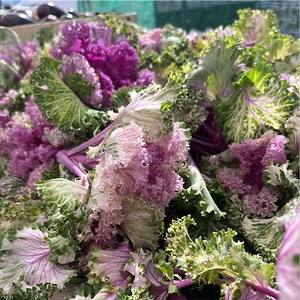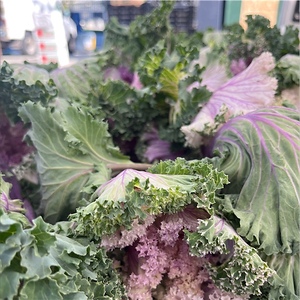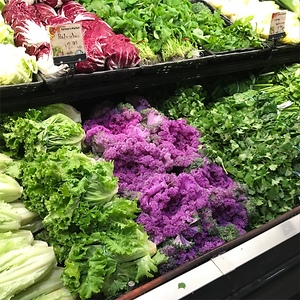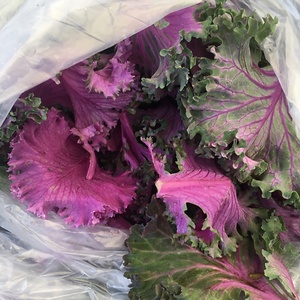

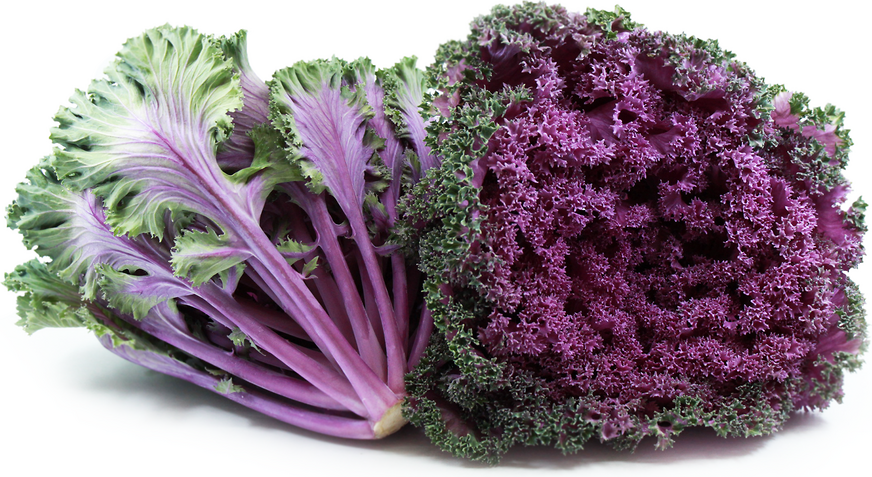
Ornamental Kale (Savoy)
Estimated Inventory, 24 ct : 9.04
This item was last sold on : 05/07/25
Description/Taste
Ornamental kale forms in compact, dense rosettes that grow low to the ground. These types do not form a head and average 30 to 45 centimeters in height and 20 to 30 centimeters in diameter. The rosettes are spreading, and the leaves are broad, pliable, and deeply serrated or ruffled. Ornamental kale appears in variegated shades of dark green, pink, purple, white, red, and cream. It is standard for varieties to be green on the outside of the rosette and bear their colorful hues in the interior portions. Ornamental kale leaves have a tough, crisp, and chewy consistency, depending on the rosette’s maturity. Younger leaves will be more tender than older greens. The stems are thick and fibrous and are mostly discarded. Ornamental kale varies in flavor and aroma, depending on the variety. Some types may release an earthy, vegetal, cabbage-like scent, while others will be mild. Ornamental kale ranges in flavor, with mild, neutral, vegetal notes to bitter, earthy, and grassy nuances.
Seasons/Availability
Ornamental kale is available year-round, with a peak season in the winter.
Current Facts
Ornamental kale, botanically classified as Brassica oleracea var. acephala, is a general category encompassing several varieties belonging to the Brassicaceae family. The serrated to frilled greens are grown specifically for their appearance rather than flavor and are favored for their voluminous nature, cold hardiness, low maintenance, and visual interest. Ornamental kale is cultivated for decorative purposes in gardens and is also used as a colorful garnish for culinary preparations. There are two main types of Ornamental kale. Varieties with ruffled leaves are called “fringed-leaved” cultivars, and varieties with serrated leaves are known as “feather-leaved” cultivars. Popular varieties include Tokyo, Chidori, Color Up, Yokohama, Coral, Osaka, Peacock, Pigeon, and Nagoya. Ornamental kale varieties are also sometimes called Flowering kale, but it is worth noting that the plants are called flowering due to the colored leaves in the center of the rosette that create a flower-like appearance. While less common, Ornamental kale is edible, but the varieties are not commonly sold as a culinary ingredient as they are not bred for flavor. Some consumers do choose to eat Ornamental kale varieties, but they are not typically selected for professional and commercial culinary uses beyond as a garnish.
Nutritional Value
Ornamental kale has not been extensively studied for its nutritional value. Kale, in general, is a source of vitamins A, C, E, and K to maintain healthy organs, strengthen the immune system, guard the cells against free radical damage, and aid faster wound healing. Kale also provides fiber and minerals to regulate the digestive tract, including magnesium, iron, phosphorus, and calcium. Magnesium helps control daily nerve functions, iron develops the protein hemoglobin for oxygen transport through the bloodstream, and phosphorous and calcium help the body develop bones and teeth. Ornamental kale contains carotenoids and anthocyanins, organic compounds that contribute to the colorful pigments in the leaves. Anthocyanins also help reduce inflammation and support overall bodily health.
Applications
Ornamental kale is edible but is not commercially produced for these purposes. Ornamental varieties are commonly used as a garnish on plates or as an edible underlay. As a garnish, Ornamental kale is valued for its variegated coloring, texture, and ability to enhance the visual eating experience. Despite their well-known ornamental uses, some consumers choose to grow and eat Ornamental kale. It is important to note that Ornamental kale should never be foraged from public areas or garden centers without extensive background research. Many Ornamental varieties are not grown organically and may have been sprayed with pesticides or herbicides. Only consume Ornamental kale when you are entirely sure it has been grown naturally and without harmful chemicals. Ornamental kale can be used in preparations, calling for common kale, but it tends to have a more bitter flavor profile. This bitterness can be reduced by boiling the leaves. The stems can also be removed as they have a woody, fibrous texture. Ornamental kale can be prepped and tossed into salads or layered into sandwiches. They can also be added to stir-fries, simmered in soups and stews, or sauteed and served as a simple side with aromatics. Kale holds up well to steaming, braising, frying, baking, and stewing. Try coating leaves in olive oil and grilling or baking the greens in small pieces to create crisp chips. Ornamental kale pairs well with herbs such as oregano, thyme, and parsley, aromatics including shallots, onion, and garlic, tomato, sweet potatoes, and meats such as sausage, pancetta, and poultry. Whole, unwashed kale should be stored in a sealed container in the fridge, where it will keep for 3 to 5 days.
Ethnic/Cultural Info
Ornamental kale is valued worldwide for its ability to be grown in cooler climates. Most varieties can survive in temperatures down to minus fifteen degrees Celsius, making them a choice garden plant for the fall and winter. One of Ornamental kale’s distinct traits is its color-changing qualities in cold weather. When the plants are exposed to cold temperatures, the leaves will begin to change colors in 2 to 4 weeks. Cold weather suppresses chlorophyll production in the leaves, a pigment responsible for the plant’s green coloring. This suppression also enhances other colors in the leaves, like pink, white, red, and purple hues. Cold weather allows Ornamental kale varieties to develop bright color contrasts in gardens, providing visual interest during a traditionally bleak season. In the modern day, Ornamental kale has also become popular outside of the garden and is used in floral designs and bouquets. The tightly formed rosettes add volume, color, and texture to floral arrangements, and their hardy nature allows them to last without the dangers of wilting.
Geography/History
Ornamental kale is a descendant of wild types of Brassica oleracea native to the Mediterranean and the Middle East. The Greeks and Romans domesticated early forms of kale, and in the 4th century, various types were introduced to China through trade. Kale was quickly established in China as a culinary and medicinal ingredient, and the plants eventually made their way to Japan, where they were bred for their colorful, ornamental foliage. These varieties of kale later became known as Ornamental kale. In 1929, plant explorer and horticulturalist Palemon Howard Dorsett was sent by the United States Department of Agriculture to China and Japan to search for new plant species. During his time in Japan, he selected several types of Ornamental kale for introduction into the United States. Ornamental kale appeared in American seed catalogs in 1936, and since its arrival, it has evolved into a versatile plant for decorative and culinary purposes. Today, Ornamental kale is grown worldwide in commercial and home gardens.
Featured Restaurants
Restaurants currently purchasing this product as an ingredient for their menu.
| InterContinental Vistal Kitchen | San Diego CA | 619-501-9400 |
| Happy Medium SD | San Diego CA | 509-869-2279 |
| Frenchy's Hideout | San Diego CA | 858-345-7379 |
| Kingfisher | San Diego CA | 619-861-8074 |
| Bayside Landing | San Diego CA | 858-270-9200 |
| Margaritaville Hotel SD (Kitchen) | San Diego CA | 619-819-9500 |
| Camino Riviera | San Diego CA | 619-685-3881 |
| UCSD La Jolla (Pritikin Intensive) | San Diego CA | 858-657-6473 |
| Barleymash | San Diego CA | 619-255-7373 |
| Solterra Winery + Kitchen | Encinitas CA | 858-245-6146 |
| The Country Club Of Rancho Bernardo | San Diego CA | 858-487-1134 |
| Kairoa Brewing Company | San Diego CA | 858-735-0051 |
| University Club | San Diego CA | 619-234-5200 |
| Manna | Encinitas CA | 510-366-3057 |
| Waverly | Cardiff CA | 619-244-0416 |
| Tribute Pizza | San Diego CA | 858-220-0030 |
| Parkhouse Eatery | San Diego CA | 619 295 7275 |
| Prey Brewing Company | Vista CA | 760-822-4226 |
| Kettner Exchange | San Diego CA | 909-915-9877 |
| InterContinental San Diego | San Diego CA | 619-501-9400 |
| Terra Restaurant | San Diego CA | 619-293-7088 |
| Hilton Mission Valley | San Diego CA | 619-543-9000 |
| Thai One On | Carlsbad CA | 760-500-8674 |
| J & Tonys | San Diego CA | 855-634-7664 |
| The Whaling Bar | La Jolla CA | 858-355-9218 |
| La Jolla Country Club | San Diego CA | 858-454-9601 |
Recipe Ideas
Recipes that include Ornamental Kale (Savoy). One
Podcast







